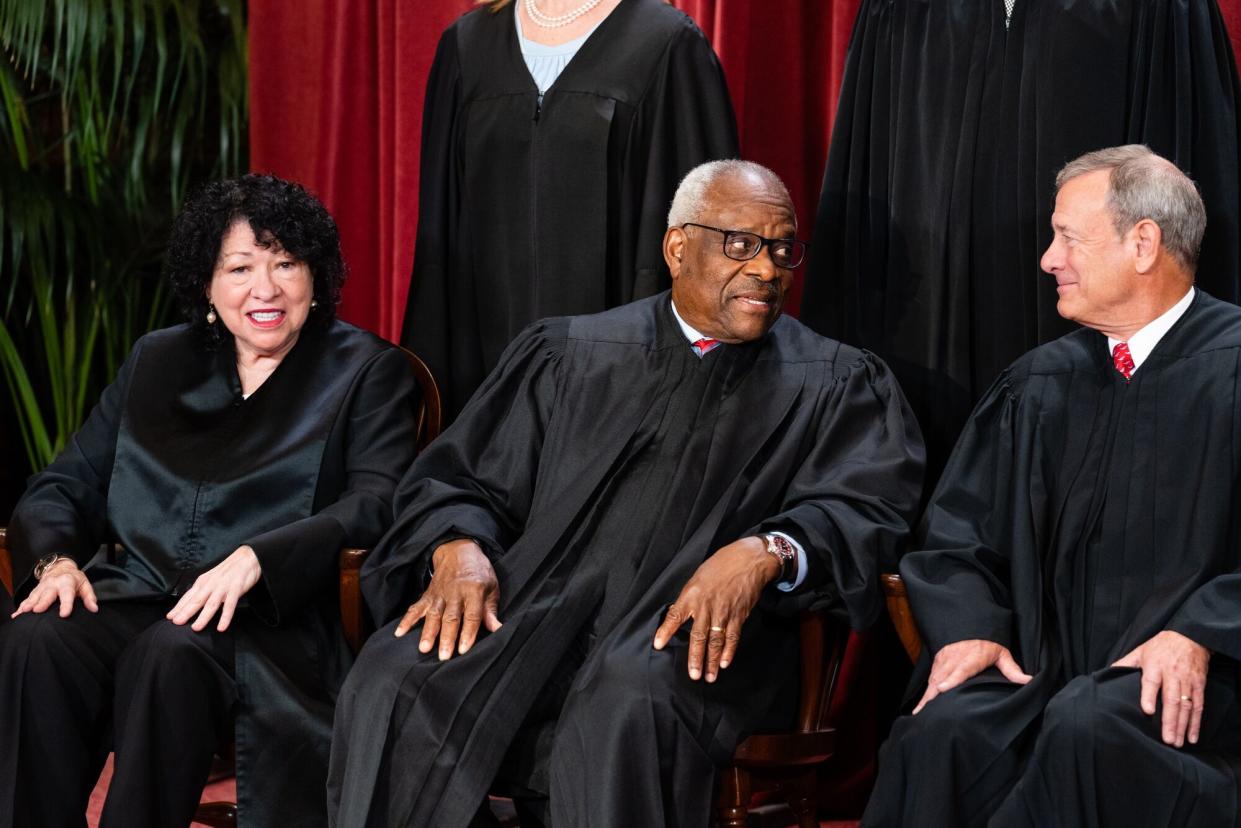Supreme Court’s Harvard Ruling Caps Chief Justice Roberts’ Long-Held View on Race

- Oops!Something went wrong.Please try again later.
- Oops!Something went wrong.Please try again later.
(Bloomberg) -- Chief Justice John Roberts at times has tried to slow the Supreme Court’s conservative revolution. But he was in the vanguard Thursday, enshrining his long-held views in a signature opinion abolishing racial preferences in college admissions.
Most Read from Bloomberg
It’s Getting a Lot Harder to Chase the Stock Rally From Here On
Tesla Tops Expectations as Price Cuts Lift Deliveries to Record
Dizzying Bond Moves Put 4% Yield in Play to Win Over Investors
Roberts’ 40-page opinion for the court said the Constitution requires the government – and in some cases private entities like Harvard College – to be colorblind, barring racial distinctions whether they benefit minorities or White people.
“Eliminating racial discrimination means eliminating all of it,” Roberts wrote. He blasted his three dissenting colleagues for trying to create “a judiciary that picks winners and losers based on the color of their skin.”
The ruling, which effectively wiped out precedents dating back to 1978, could mean fewer Black and Hispanic students at the country’s top universities and force hundreds of schools to revamp their admissions policies.
“The opinion is the culmination of the chief’s longstanding efforts to limit what he views as unconstitutional uses of race in the educational context,” said Roman Martinez, a Washington appellate lawyer at Latham & Watkins LLP and former law clerk to Roberts.
It’s a view of the Constitution and its equal protection clause that dates back to Roberts’ time as a lawyer in President Ronald Reagan’s administration in the 1980s, and then as President George H.W. Bush’s second-ranking Supreme Court lawyer from 1989 to 1993. In those roles, he established himself as a forceful critic of racial preferences.
By the time Roberts joined the court in 2005 as an appointee of Republican President George W. Bush, the new chief justice was ready to make bold public statements on the issue.
“It is a sordid business, this divvying up by race,” he wrote in a 2006 redistricting case. The following year, he said in a school integration case that “the way to stop discrimination on the basis of race is to stop discriminating on the basis of race.”
‘Things Have Changed’
In 2013 he turned those views into a far-reaching ruling that nullified a key provision of the Voting Rights Act, the landmark 1965 law aimed at protecting Black voters at the polls. The ruling gutted a provision that had required states with a deep history of discrimination – mostly southern ones – to get federal preclearance before changing their voting maps or election procedures.
Writing for the court, Roberts said barriers to Black voting, once widespread in the South, had largely disappeared. “Nearly 50 years later, things have changed dramatically,” Roberts wrote.
Roberts’ approach toward race has drawn sharp criticism from civil-rights advocates and liberal constitutional scholars.
“He has a very simplistic and idealistic vision of race,” said Melissa Murray, a professor at New York University School of Law. He embraces “formal equality that doesn’t really take into account the very many ways in which race continues to shape society.”
Roberts pulled back a bit on one front this month when he reinforced the use of the Voting Rights Act to create voting districts likely to elect Black or Hispanic candidates. Roberts joined Justice Brett Kavanaugh and the court’s liberals in saying the court’s precedents under that law required creation of a second heavily Black congressional district in Alabama.
‘Greatest Opinion’
But his latest opinion put him firmly in the conservative camp. All five of his Republican-appointed colleagues joined his opinion in full, and conservative commentators hailed his reasoning.
“The chief’s opinion strikes me as his greatest opinion in his eighteen years on the court,” Ed Whelan of the Ethics and Public Policy Center said in a blog post.
Roberts’ assertiveness on race stands in contrast to his reticence on abortion a year ago, when his five conservative colleagues voted to overturn the landmark Roe v. Wade ruling. Roberts said he would have stopped short of taking that step, bluntly admitting he wasn’t sure about the constitutionality of many abortion restrictions.
He wrote at the time that his colleagues — both those in the majority and the dissenters — “display a relentless freedom from doubt on the legal issue that I cannot share.”
In the affirmative action case, Roberts showed no signs of doubt.
Most Read from Bloomberg Businessweek
The Air Jordan Drop So Hot It Blew Up an Alleged $85 Million Ponzi Scheme
How a Prison Gang Inspired by Hollywood Heists Stole $23 Million
EBT Skimmers Are Draining Millions of Dollars From the Neediest Americans
How a $100 Cheetah Cub Becomes an Illegal $50,000 Status Symbol
©2023 Bloomberg L.P.


